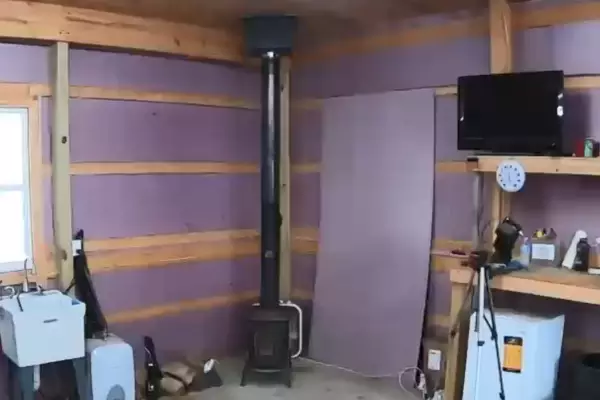A garage, while often overlooked, plays an essential role in preserving the value of your property. However, an uninsulated garage can pose numerous problems, primarily related to temperature regulation. Thus, focusing on proper heating methods becomes critical.
Indeed, having an uninsulated garage does not mean resigning oneself to freezing temperatures in the winter or sweltering heat in the summer. Solutions exist to regulate these spaces effectively. Implementing the right heating solutions in your uninsulated garage can enhance comfort, utility, and overall value.
Key to this is understanding the role of insulation in temperature control. But even without insulation, certain techniques and strategies can help maintain a comfortable garage environment. These methods are particularly crucial for those who use their garages as additional functional spaces, such as home gyms.
Contents
Assessing Your Garage
It’s crucial to evaluate the condition of your garage before proceeding with any heating plans. The effectiveness of heating methods can vary depending on factors like garage size, the materials used in construction, and the current state of the garage.

Why Insulation Matters
Insulation helps regulate temperatures, keeping your garage warm in the winter and cool in the summer. But if insulation isn’t an option, we can still find workarounds to heat our garage effectively.
Best Way to Heat a Garage Gym
The garage can often serve as an excellent location for a home gym, providing ample space for workout equipment. However, maintaining an appropriate temperature is essential, not just for your comfort but also for the longevity of your gym equipment.
One of the most efficient options is an electric heater, preferably one with a built-in thermostat for precise temperature control. These heaters can generate warmth quickly and disperse it evenly throughout the space. However, keep in mind that some models can consume substantial electricity, impacting your energy bills.
In contrast, propane heaters are excellent for larger spaces due to their higher heat output. While more economical, they require proper ventilation due to the combustion process, making them unsuitable for poorly ventilated areas.
Infrared heaters, meanwhile, are a superb option for those seeking energy efficiency. They warm up objects directly, much like sunlight, providing comfortable and consistent heat. This type of heating doesn’t waste energy on heating the surrounding air, making it an ideal choice for uninsulated garages.
Practical Garage Heating Tips
Beyond choosing the right type of heater, several practical tips can help you enhance your garage’s warmth.
Insulate the Garage Door and Windows
While the garage itself may be uninsulated, you can still take steps to insulate the garage door and windows. This will prevent cold air from seeping in and warm air from escaping.

Seal Gaps and Cracks
Over time, garages may develop cracks or gaps, particularly around the doors and windows. Sealing these can prevent drafts that let cold air in and warm air out.
Position the Heater Correctly
The position of your heater can significantly affect its efficiency. Generally, it is best to place it in the area where heat is most needed. For instance, if you’re using the garage as a gym, the heater should be positioned near your workout area.
Warming Up Your Garage
Even with the most efficient heating method, keeping your garage warm can be a challenge. However, a few strategies can make a significant difference.
Regular Maintenance
Regularly maintaining your heating system is essential for optimal performance. This includes cleaning, inspections, and prompt repairs.
Install Weather Stripping
Installing weather stripping around your garage doors and windows can prevent drafts and help maintain a warm temperature inside.

How to Warm Up a Garage in Winter
Winter can pose a unique set of challenges when it comes to heating your garage. However, with a few tweaks and preparations, you can ensure a warm and cozy garage even during the coldest months.
Insulate Your Garage Door
While the garage may be uninsulated, insulating your garage door with foam panels can help retain heat and minimize the chill factor.
Seal Your Windows
Ensure all windows are adequately sealed. If your garage windows are single-pane, consider applying a window insulation kit for added protection against the cold.
Strategically Place Your Heater
Ensure your space heater is strategically placed for optimal warmth distribution. If using a floor-based model, consider elevating it on a stable platform to distribute heat more evenly.
Energy Efficient Garage Heating
While heating your garage, it’s essential not to overlook energy efficiency. The right choices can help you save on your energy bills and reduce your environmental footprint.
Choose an Energy-Efficient Heater
Some heaters are specifically designed for energy efficiency. For instance, infrared heaters heat objects directly, which means less energy is wasted in heating the air.
Use a Timer
A timer can help ensure your heater is only running when necessary. This can significantly reduce energy consumption and save on costs.
Maintain Your Heater
A well-maintained heater runs more efficiently, saving energy and prolonging the life of the heater. Regular cleaning and maintenance can ensure your heater remains in top condition.
Frequently Asked Questions
What is the most energy-efficient way to heat a garage?
Infrared heaters are considered the most energy-efficient method of heating a garage. They heat objects directly instead of the air, providing warmth more efficiently.
Can I use an old home heater in my garage?
While it’s possible to use an old home heater, it’s important to ensure that it’s safe and fit for garage use. Heaters designed for indoor use may not be suitable for garages due to different safety and heating requirements.
Is it safe to leave a heater on in the garage overnight?
This largely depends on the type of heater you’re using. Some heaters are designed for continuous operation, while others are not. Always refer to the user manual or consult with the manufacturer for specific safety guidelines.
Conclusion
Proper heating of an uninsulated garage may seem challenging, but with the right approach, it is indeed manageable. Implementing strategic methods and adopting efficient heaters can transform your garage into a warm, welcoming space.
Every garage is unique, so the heating solutions will differ. Your goal should be to maintain comfort while ensuring energy efficiency. While insulation may be ideal, its absence doesn’t leave you helpless in the face of cold.
Finally, while we’ve discussed various strategies and heaters, safety should never take a backseat. Whatever heating method you choose for your garage, ensure it adheres to safety standards. Your garage, after all, is not just a storage space but an extension of your home.

